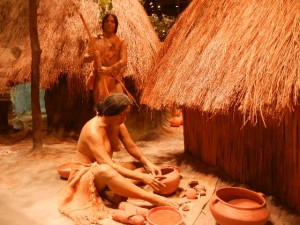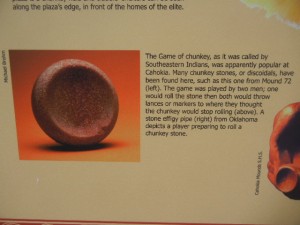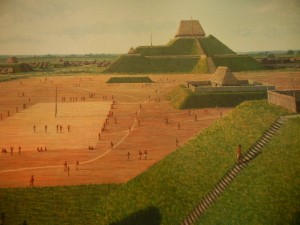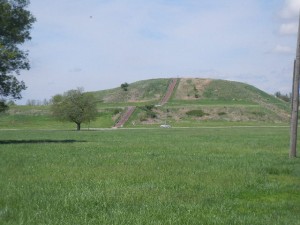17 April: A travel day, from near the southern tip of Illinois north to just outside of East St. Louis, Illinois, to get close to tomorrow’s destination of Cahokia Mounds. On the way we stopped at the Public Library in Sparta, where Paul’s great-great-great grandfather John Stitt died, but had no luck in finding any record of his death or where he is buried. We don’t know whether he lived in Sparta for a while, or was just traveling through when he died. He was living in Oxford, Ohio, in 1860; died in September 1861 in Sparta, Ill.; and his widow Jane Stitt was living in Monmouth, Ill., with two of their daughters in 1870 and 1880.
18 April: After we had a fun on-line video session waving back and forth with our granddaughter Corwyn (her newest skill), we spent a few hours at Cahokia Mounds State Historical Site (also designated as a National Historic Site and a UNESCO World Heritage Site). Cahokia is what archaeologists call the very large city that was here in the Mississippi River floodplain from roughly 950 to 1350, whose occupants built many large earthen mounds. These people were part of what is called the Mississippian culture, in what is now the southeastern U.S. and farther up the Mississippi valley. The reason the area was abandoned around 1350 is not known for certain, nor which modern tribes are descended from them. They relied heavily on agriculture (corn, squash, sunflowers, and other crops), supplemented by hunting and gathering, and also had extensive trade networks with people at least as far away as the Great Lakes and the Gulf of Mexico. Their mounds were built of local earth carried in woven baskets (they did not have the wheel or domestic animals other than dogs). The largest mounds were truncated (flat-topped) pyramids, and some had small pole and thatch buildings on top. There was a massive log stockade around the central core of the city. In its time, Cahokia was as large as or larger than the largest cities of Europe such as London and Paris. Cahokians had all the attributes we associate with civilization and cities except for a written language. The film and exhibits at the visitor center are first class, and there are walking trails with interpretive signs throughout the extensive grounds.


